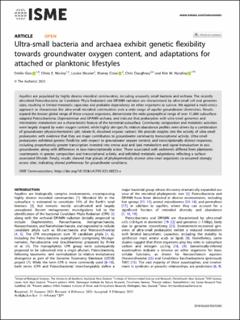| dc.contributor.author | Gios, Emilie | |
| dc.contributor.author | Mosley, Olivia E. | |
| dc.contributor.author | Weaver, Louise | |
| dc.contributor.author | Close, Murray | |
| dc.contributor.author | Daughney, Chris | |
| dc.contributor.author | Handley, Kim M. | |
| dc.date.accessioned | 2023-03-02T12:00:15Z | |
| dc.date.available | 2023-03-02T12:00:15Z | |
| dc.date.created | 2023-03-01T16:02:13Z | |
| dc.date.issued | 2023 | |
| dc.identifier.issn | 2730-6151 | |
| dc.identifier.uri | https://hdl.handle.net/11250/3055334 | |
| dc.description.abstract | Aquifers are populated by highly diverse microbial communities, including unusually small bacteria and archaea. The recently described Patescibacteria (or Candidate Phyla Radiation) and DPANN radiation are characterized by ultra-small cell and genomes sizes, resulting in limited metabolic capacities and probable dependency on other organisms to survive. We applied a multi-omics approach to characterize the ultra-small microbial communities over a wide range of aquifer groundwater chemistries. Results expand the known global range of these unusual organisms, demonstrate the wide geographical range of over 11,000 subsurfaceadapted Patescibacteria, Dependentiae and DPANN archaea, and indicate that prokaryotes with ultra-small genomes and minimalistic metabolism are a characteristic feature of the terrestrial subsurface. Community composition and metabolic activities were largely shaped by water oxygen content, while highly site-specific relative abundance profiles were driven by a combination of groundwater physicochemistries (pH, nitrate-N, dissolved organic carbon). We provide insights into the activity of ultra-small prokaryotes with evidence that they are major contributors to groundwater community transcriptional activity. Ultra-small prokaryotes exhibited genetic flexibility with respect to groundwater oxygen content, and transcriptionally distinct responses, including proportionally greater transcription invested into amino acid and lipid metabolism and signal transduction in oxic groundwater, along with differences in taxa transcriptionally active. Those associated with sediments differed from planktonic counterparts in species composition and transcriptional activity, and exhibited metabolic adaptations reflecting a surfaceassociated lifestyle. Finally, results showed that groups of phylogenetically diverse ultra-small organisms co-occurred strongly across sites, indicating shared preferences for groundwater conditions. | en_US |
| dc.language.iso | eng | en_US |
| dc.rights | Navngivelse 4.0 Internasjonal | * |
| dc.rights.uri | http://creativecommons.org/licenses/by/4.0/deed.no | * |
| dc.title | Ultra-small bacteria and archaea exhibit genetic flexibility towards groundwater oxygen content, and adaptations for attached or planktonic lifestyles | en_US |
| dc.title.alternative | Ultra-small bacteria and archaea exhibit genetic flexibility towards groundwater oxygen content, and adaptations for attached or planktonic lifestyles | en_US |
| dc.type | Journal article | en_US |
| dc.description.version | publishedVersion | en_US |
| dc.rights.holder | © 2023 The Authors | en_US |
| dc.subject.nsi | VDP::Matematikk og Naturvitenskap: 400::Basale biofag: 470 | en_US |
| dc.source.journal | ISME Communications | en_US |
| dc.identifier.doi | 10.1038/s43705-023-00223-x | |
| dc.identifier.cristin | 2130607 | |
| cristin.ispublished | true | |
| cristin.fulltext | original | |
| cristin.qualitycode | 0 | |

